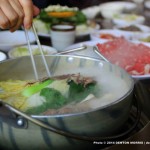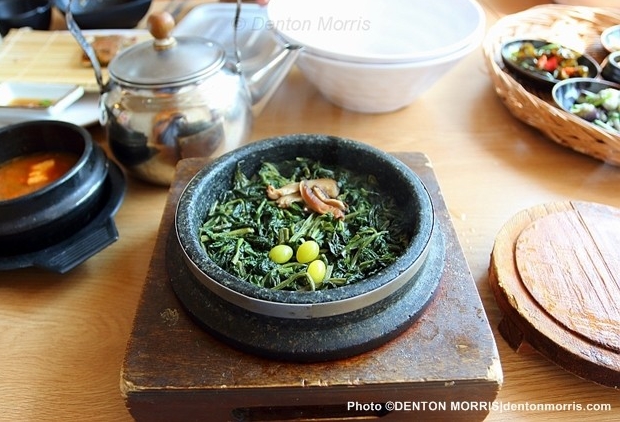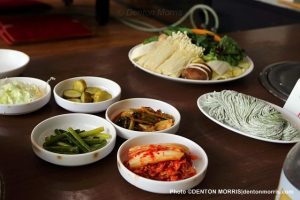 Article by Jae-Ha Kim
Article by Jae-Ha Kim
Photos by Denton Morris
(Chicago Tribune)
When I was young, I went through a phase where I hated Korean food. My mother would make fresh, home-cooked meals from scratch. And instead of realizing what a treat that was, I would ask why we couldn’t just eat TV dinners like all my friends. But these days, there’s no cuisine I enjoy more than Korean. And if someone else is willing to cook it for me, all the better!
So when my family and I traveled to South Korea this fall, eating well was a top priority.
Americans are familiar with Korean BBQ beef and kimchi (the spicy, fermented cabbage dish that’s now touted as a good source of probiotics). And while those dishes certainly are components of the Korean diet, there’s so much more.
Let me take a moment to give a shout out to Daegu. The fourth largest city in Korea – after Seoul, Busan and Incheon – Daegu has a bit of a maligned reputation. When I talked to people about what we might do there, the most common answer was, “Nothing. There’s nothing to see, no place worth eating at. The best restaurant there is McDonald’s.”
Oh contraire.
My little family enjoyed some of our best days in Daegu, visiting the local temples, taking our son to the child-friendly Eco Park at Herb Hillz and enjoying the city’s cuisine.
After visiting the Tongil-daebul Buddha on Mount Palgongson, we had lunch at a little restaurant that served a set meal that included pork belly, soup and vegetables. But my favorite dish was Gondeure Dolsot Bap, which is lightly seasoned cirsium setidens served over rice in a piping hot stone bowl. The vegetables have a slightly bitter taste, which you can neutralize with a few spoonfuls of soybean paste soup or some pickled vegetables. I enjoyed it simply mixed together with the rice. It was hearty, refreshing, healthy and delicious.
Beef is relatively expensive in Korea, but I found the seafood to be reasonably priced, especially in the coastal city of Busan. If you like sashimi, you’ll love the thinly sliced pieces of fish, served with a spicy, red-pepper based dipping sauce. Also try the dongnae pajeon – a Busan delicacy. The crispy, savory pancake is filled with green onions, seafood and beef.
My 6-year-old son is an adventurous eater, but he still gets homesick for his comfort foods, such as a bowl of white rice, some crisped and seasoned seaweed and mandu (Korean fried dumplings). At many of the nicer restaurants we dined at, we couldn’t get any of this. And at the more basic restaurants, the mandu was frozen and reheated, rather than made fresh.

For mandu like the kind my mother used to make when I was a child, we headed to the tourist-friendly neighborhood of Insadong in Seoul. Outside the tiny Bukchon Son mandu restaurant, where the line to get inside wrapped around the corner, we could see the workers stuffing the fresh plump dumplings with mung beans, pork, tofu and assorted vegetables. Served right out of the sizzling fryer, they were greasy, but also ridiculously delicious. We bought extra to eat later in our hotel, and they held up well without needing to be reheated.
One of the things that surprised me was the number of restaurants that didn’t serve rice at the beginning of the meal, but rather at the end – almost like a palate cleanser.
“Traditionally you eat the meat first,” says author Taekyung Chung, who co-wrote “The Korean Table” (Tuttle Publishing, $27.95) with Debra Samuels. “Then side dishes and rice at the end. Many important elements of the Korean diet are vegetable based, with standard items like kimchi and namul (vegetables), being prominent non-meat dishes.”
→ SIDEBAR ←
As with all cuisines, there are local specialties that the natives love that may be a bit much for foreign palates to stomach. In an American bar, you might have some peanuts or popcorn with your beer. In Korea, you’re just as likely to be served a small bowl of dried cuttlefish and anchovies.
A popular dessert in Korea is patbingsu. Originally, the treat consisted of shaved ice, sweet rice cakes and red bean paste. These days, the shaved ice base is covered with everything from condensed milk, various fruits, syrup, cereal, nuts etc. Personally, I find it disgusting. But I’m also not a fan of bubble tea (boba milk tea) or milk-based smoothies.
While Koreans have a rightly-deserved reputation for enjoying red-hot spicy meals, they like to add a bit of sweetness to some dishes we consider to be savory. My son was surprised when his plate of waffles was served with a side of tomatoes. I explained to him that in many Korean households, tomatoes are served with a tiny bit of sugar sprinkled on top. People think this is weird. But if you haven’t eaten chilled, sweetened slices of tomatoes, you’re missing out on a truly tasty treat.
But then there are other items that are ruined by too much sweetness. For instance, K-pop star Hyuna won a makeshift cooking contest by serving a perfectly nicely sectioned grapefruit slathered with condensed milk. And if you see garlic bread sold in stores, be warned that there’s a good chance that it’ll have sugar sprinkled on top.
© JAE-HA KIM | ALL RIGHTS RESERVED












Mmmm I’m hungry now!
yummy!
신선로. it’s expensive but would be a good dish especially in winter.
Last time I was in daegu, in laws ordered pizza ( green tea crust, of course, with corn, potatoes, etc on top. Crust was stuffed with sweet potatoes. Too sweet 🙁 Not sure why sugar is added to so many “western foods” in korea. it was terrible in my opinion. sugary green tea crust is not my thing. I like green tea but i don’t like it bastardized. So many of the western dishes available, spagetti, pizza, bread (in general), italian dishes etc. so sugary tasting. weird since usually korean food is a combo of a sour and sweet but when it comes to western food there is not “sour” just sweet. My MIL was trying to be sweet and give me a break from “Korean food” so she ordered it for dinner.
One of the common complaints from true foodies is that Korean food in general has become too sweet. Some blame the Korean food served in the U.S. that was sweetened to cater to the Western palate, kind of like how Chinese food was bastardized in America to appeal to Americans. Korean-Americans then bring their sweetened versions of Korean food back to Korea, and it catches on there and continues in a cycle. Does anyone know if what I’ve said is true?
Mouth is watering!
Loved this article…but I didn’t think it was weird to put a little sugar on chilled tomatoes. I usually prefer all my fruit and vegetables chilled. I don’t use raw sugar or salts anymore. Now I think I will go in my fridge and eat some kim-chi!
Oh my golly!!! This looks so delicious!!!!!
That is it I am going to get some Korean food this weekend
We have seen and eaten at there! Awesome!
look like delicious and make me hunggry
I love Korean food and hope to get to Korea one day. Thank you for this mouthwatering article!